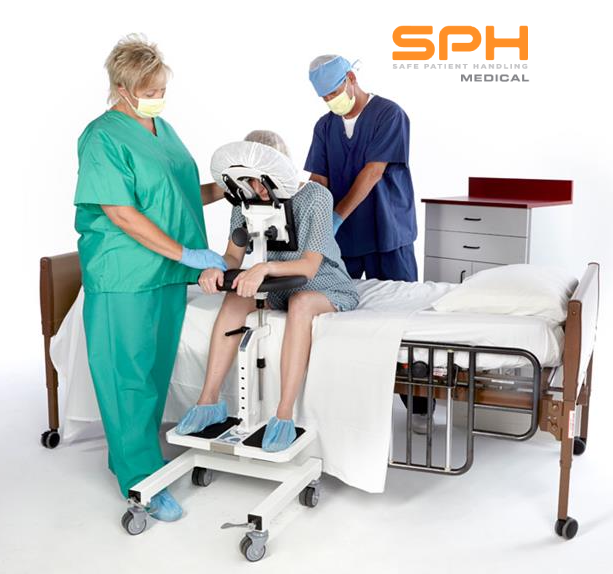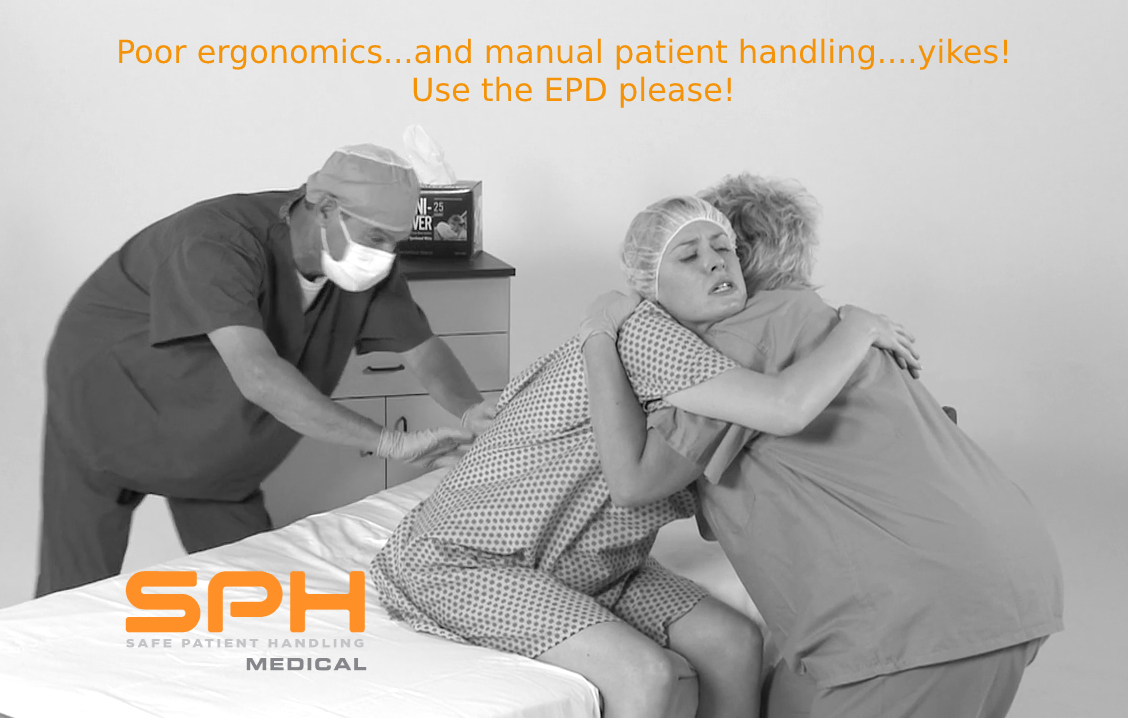Epidural Pain Relief: Positioning Device
An Epidural Chair is a positioning device that helps keep patients and nursing staff safe. The EPD provides safe positioning during epidurals by reducing risk of injury and providing a comfortable and stable position throughout epidural or spinal block injections and other similar procedures. The EPD is a massive improvement over manual positioning techniques, where nurses would provide an unstable bedside table with a pillow to lean on and then somehow position the patients feet on a stool or chair. The old fashioned manual handling method of positioning patients presents many risks to staff and patients that the Epidural Chair solves with ease.
The EPD is a revolutionary, modern patient positioning device that can typically be found in three hospital departments including Labor and Delivery, Surgery, and Imaging. In the Labor and Delivery unit expectant mothers are positioned safely for an epidural injection to reduce the pain of labor and childbirth. The surgery department is using the EPD for Spinal Blocks which are now commonplace for ortho surgeries. Those patients about to undergo surgery for a total knee often get a Spinal Block and the hospital staff are faced with positioning them safely just like the L&D patients. The imaging department is typically using the EPD to position patients during Thoracentesis; a procedure that involves draining the plural cavity between the lungs from excess fluid. In all cases the Epidural Chair provides a stable and comfortable platform that improves staff safety by removing the manual handling, positioning, and static holds. It also prevents unexpected reflex movement and spinal block by using the device’s adjustable features.
Importance of Safe Positioning During Epidurals
Proper positioning involves properly maintaining a neutral body alignment and flexed spine position to open up the vertebral spaces to enable correct needle placement while avoiding unexpected patient movement.
Stable, Comfortable, and Safe
Preparing for childbirth or a joint replacement can’t be described as comfortable. However hospital staff try their best to make patients feel comfortable and safe. In the past the nurse assisting the patient would be doing all patient care tasks manually, meaning that they would be pushing, pulling and holding patients to achieve the proper positioning. Now nursing and anesthesia technicians have the EPD. The EPD provides a stable platform for the patient to lean on and hold rather than the nurse. It improves patient comfort with the soft padded surfaces and reduces patients’ anxiety. Patient safety and staff safety are improved with the SPH Medical Epidural Chair.
Maintaining Patients’ Dignity
As patients are getting larger and heavier hospital staff are faced with patient care tasks that put them at risk of injury. Often times patients of significant size feel self conscious about their weight and the need for extra hospital staff to assist them compared to normal sized patients. Using the right type of assistive tools like the SPH Medical EPD. The EPD has a 600 lb weight capacity enables nursing staff to use one standardized device for all patients and provides safe positioning during epidurals. It no longer has to be an exception or all hands on deck call to other staff members to come and help support this patient. The use of the EPD can improve a patients’ sense of dignity and satisfaction about the care they received in the hospital.
Maximum Visibility and Access
The EPD helps the patient achieve the optimum position for needle placement and reduces the risk of complications below.
Risks to the Patient
Epidural injections are typically safe, but they have certain side effects that affect people differently. The side effects include:
- Low blood pressure. Your blood pressure may fall slightly after having an epidural. In some patients, the situation escalates, increasing the odds of other dangers to a subject.
- Inadequate pain relief. The injection may not block your pain entirely.
- Breathing problems. This is common in patients with respiratory-related complications.
- Temporal nerve damage. Though uncommon, the needle can damage the nerves when handled wrongfully.
- Infections. They are primarily skin-related conditions around the injected area.
The EPD Provides Safe Positioning During Epidurals:
- Patients’ Fear and Anxiety resulting in sudden movements. Nurses supporting a patient manually are at risk of injury when a patient makes a sudden movement in the wrong direction.
- Holding or supporting patients – ie static holds
- Applying counter-pressure
- Trying to hold onto a patient and the bedside table and a stool all at the same time
- Catching a falling patient
Transmission of infections is a concern in hospital and surgical departments. Hospital staff have infection prevention nurses that develop evidence based plans for the hospital and every department. Using an EPD has been an essential tool during the era of COVID-19. It allows for a fewer nurses to provide safe positioning during epidurals with minimal contact and it is easily cleaned and disinfected.
SPH Medical and Safe Positioning During Epidurals
In conclusion, the Epidural Positioning Device, or Epidural Chair, is a valuable if not essential tool that can improve both patient safety and nursing safety in multiple hospital departments.

